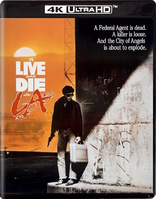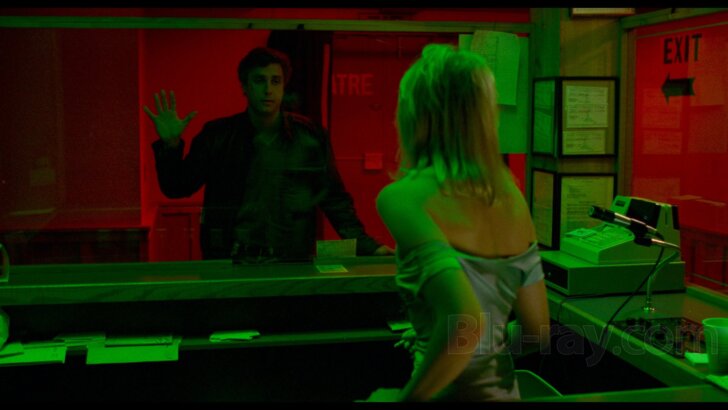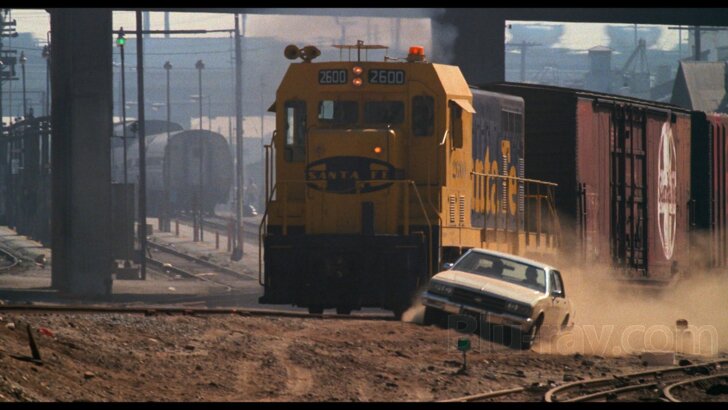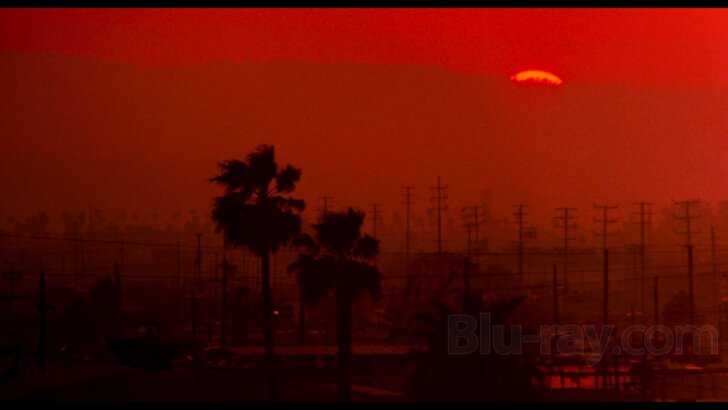To Live and Die in L.A. 4K Blu-ray Movie
HomeTo Live and Die in L.A. 4K Blu-ray Movie 
4K Ultra HD + Blu-rayKino Lorber | 1985 | 116 min | Rated R | Jul 18, 2023

Movie rating
7.8 | / 10 |
Blu-ray rating
| Users | 4.6 | |
| Reviewer | 5.0 | |
| Overall | 4.6 |
Overview
To Live and Die in L.A. 4K (1985)
When his partner is murdered just days before retirement, Secret Service Agent begins an obsessive hunt for the killer counterfeiter and all-round psychopath.
Starring: William Petersen, Willem Dafoe, John Pankow, Debra Feuer, John TurturroDirector: William Friedkin
| Drama | Uncertain |
| Crime | Uncertain |
| Film-Noir | Uncertain |
| Thriller | Uncertain |
| Action | Uncertain |
Specifications
Video
Video codec: HEVC / H.265
Video resolution: 4K (2160p)
Aspect ratio: 1.85:1
Original aspect ratio: 1.85:1
Audio
English: DTS-HD Master Audio 5.1 (48kHz, 24-bit)
English: DTS-HD Master Audio 2.0 (48kHz, 24-bit)
Subtitles
English
Discs
Blu-ray Disc
Two-disc set (2 BDs)
4K Ultra HD
Packaging
Slipcover in original pressing
Playback
Region A (locked)
Review
Rating summary
| Movie | 5.0 | |
| Video | 4.5 | |
| Audio | 5.0 | |
| Extras | 4.5 | |
| Overall | 5.0 |
To Live and Die in L.A. 4K Blu-ray Movie Review
Reviewed by Dr. Svet Atanasov July 31, 2023William Friedkin's "To Live and Die in L.A." (1985) arrives on 4K Blu-ray courtesy of Kino Lorber. The supplemental features on the release include archival audio commentary by William Friedkin; archival program with William Petersen; archival program with Debra Feuer; archival documentary on the making of the film; vintage promotional materials; and more. In English, with optional English SDH subtitles for the main feature. Region-Free.

Paper to burn
L.A. noir is a made-up subgenre that exists only because several contemporary critics decided they could use it to describe a rather large group of films with similar stylistic identities. I am unsure if the first of these critics to think of L.A. noir was French, but if it is proven that he was, I will not be shocked. After all, a French critic legitimized Soleil noir, another artificial subgenre, that has had quite a bit of traction, too. I do not like bringing up these subgenres, but I must concede that L.A. noir is very convenient to have because it groups some quite interesting and stylistically similar genre films.
The best of these genre films and the one that displays all the major qualities that are associated with L.A. noir is William Friedkinís To Live and Die in L.A. Completed in 1985, To Live and Die in L.A. is a close relative of two iconic films, The Naked City and The French Connection, and boasts a special contemporary identity. It takes its authenticity very, very seriously, but it has an equally particular understanding of style. Proper use of location(s) is of utmost importance to it, too.
In an archival program included on this release, Friedkin discusses in great detail his desire to capture on film the flip side of L.A. without embellishing any parts of it. With a few minor adjustments, Friedkinís summary can easily be used to describe what Jules Dassin did in 1948 with The Naked City, which is why in it the ambience and pulse of New York City are just as effectively preserved. On the other hand, the staging and management of the action in To Live and Die in L.A. are modeled to replicate as best as possible what was done in The French Connection in 1971. In other words, even though To Live in Die in L.A. is an original project, it is essentially a multi-layered variation on a classic film noir concept and action staging and management.
Friedkinís comments on the nature of the characterizations are hardly surprising, too. In To Live and Die in L.A., all characters are flawed human beings whose desires and goals are very closely intertwined. (One of Friedkinís most interesting comments is that he did not think there was much of a difference between the cops and their targets. The cops had a badge that empowered them and opened different doors in their work, but that was basically it). Needless to say, all characters are actors in the game of life and constantly perform in consequential acts.
The story that To Live in Die in L.A. tells is a complex mosaic of several such consequential acts. In one of these acts, Detective Richard Chance (William Petersen) loses his partner (Michael Greene) days before he is to retire and vows to track down his killer. In another act, an extremely talented artist-turned-counterfeiter (Willem Dafoe) begins flooding L.A. with fake dollars, but after one of his mules is arrested becomes suspicious of a close associate (John Turturro) and reaches out to a well-connected client (Steve James) with a request to permanently silence him. In another act, Chance and his new partner (John Pankow) begin improvising to get the counterfeiter but make crucial errors and an undercover FBI agent dies. When events from each act start overlapping, L.A. begins looking like a giant casino where all kinds of different people are willingly and unwillingly betting their lives.
The masterful depiction of the overlapping is what elevates To Live and Die in L.A. above all other films linked to L.A. noir. It is done at an incredible, often exhausting tempo, but the drama that flourishes in it is strikingly organic. Also, somehow Friedkin and cinematographer Robby Muller manage to flood the drama with some absolutely breathtaking visuals from the rougher areas of L.A.
*Another fine film from the 1980s that very effectively preserves the flexible personality and pulse of L.A. is Hal Ashbyís action thriller 8 Million Ways to Die.
To Live and Die in L.A. 4K Blu-ray Movie, Video Quality 

Kino Lorber's release of To Live and Die in L.A. is a 4K Blu-ray/Blu-ray combo pack. The 4K Blu-ray is Region-Free. However, the Blu-ray is Region-A "locked".
Please note that some of the screencaptures that appear with this article are taken from the 4K Blu-ray and downscaled to 1080p. Therefore, they do not accurately reflect the quality of the 4K content on the 4K Blu-ray disc, including the actual color values of this content.
Screencaptures #1-24 are from the Blu-ray.
Screencaptures #27-35 are from the 4K Blu-ray.
I have two other releases of To Live and Die in L.A. -- MGM's original U.S. release and Arrow Video's UK release. I did not do any comparisons with the original release. I compared several sequences from the 1080p presentation on this release and Arrow Video's presentation. They produced visuals that looked practically identical on my system. If there are any discrepancies, they must be minuscule and impossible to detect without pulling out specific screencaptures.
I viewed the native 4K presentation with Dolby Vision. I did not test it with HDR. I thought that the overall quality of the visuals was unquestionably better, but there were two areas where the improvements were always easy to appreciate. First, in native 4K, all visuals convey superior density levels that made them much more attractive. In 1080p, there are several areas that can appear a tad loose, like the opening footage where the cars are seen approaching the hotel, so on a bigger screen the positive difference from the move to 4K becomes undeniable. This is an improvement that also has an effect on the fluidity of the visuals, so all of the faster-moving footage from the wild chase for instance benefits as well. Second, quite a few darker areas boast superior detail, though not all darker areas can look better. Why? To be honest, I think that I prefer how several areas with lush colors look in 1080p because they reveal a richer neon-esque appearance, which I associate with L.A. noir. I think that a few primaries and supporting nuanced appeared a tad dimmed in 4K, though I still like the overall color balance a lot. The rest is magnificent. I did not spot any anomalies in the grain management. Image stability was outstanding. The entire film looks spotless as well. One last thing. I used my 4K player to upscale the 1080p presentation so that I can see how it looks projected on a big screen. I thought that the upscaled content looked fabulous.
To Live and Die in L.A. 4K Blu-ray Movie, Audio Quality 

There are two standard audio tracks on this release: English DTS-HD Master Audio 2.0 and English DTS-HD Master Audio 5.1. Optional English SDH subtitles are provided for the main feature.
I have always viewed To Live and Die in L.A. with the 2.0 track, so this time I spent a lot of time with the 5.1 track. To be honest, while my preference would be for the 2.0 track, I like both tracks a lot, and in some areas, I think that the 5.1 track definitely excels. One of these areas begins with the murder of the undercover FBI agent. The wild chase through East L.A. has some great moments, too. The dialog is very clear, sharp, clean, and easy to follow. I did not encounter any anomalies to report in our review.
To Live and Die in L.A. 4K Blu-ray Movie, Special Features and Extras 

4K BLU-RAY DISC
- Commentary - this archival audio commentary was recorded by William Friedkin. It is an outstanding commentary -- like all commentaries Mr. Friedkin has done over the years -- that addresses numerous areas of the production history of To Live and Die in L.A.. For example, there are some very interesting comments about the casting of William Petersen and how a lot of scenes were essentially improvised to capture raw feelings and emotions. Also, there is excellent information about several locations in L.A. where key sequences were shot and some challenges that had to be overcome, the ambience and tone of the film, and the stylish '80s soundtrack.
- Commentary - this archival audio commentary was recorded by William Friedkin. It is an outstanding commentary -- like all commentaries Mr. Friedkin has done over the years -- that addresses numerous areas of the production history of To Live and Die in L.A.. For example, there are some very interesting comments about the casting of William Petersen and how a lot of scenes were essentially improvised to capture raw feelings and emotions. Also, there is excellent information about several locations in L.A. where key sequences were shot and some challenges that had to be overcome, the ambience and tone of the film, and the stylish '80s soundtrack.
- Taking a Chance - in this archival program, William Petersen discusses in great detail how he was approached and consequently cast to play his character in To Live and Die in L.A., what it was like to interact and work with William Friedkin in L.A., his interactions with John Pankow (with some hilarious comments about the filming of the wild chase footage), the presence and personality of L.A. in the film and how both were managed by Friedkin, etc. An outstanding program that was produced by the folks at Shout Factory for this Collector's Edition of To Live and Die in L.A.. In English, not subtitled. (21 min).
- Rennaisance Woman in L.A. - in this archival program, Debra Feuer recalls how she was cast to play her character (the initial plan was for her to be a bisexual mulato), the filming of specific sequences and her character's presence in them, William Friedkin's directing methods, etc. The program was produced by Shout Factory. In English, not subtitled. (15 min).
- Doctor for a Day - in this archival program, Dwier Brown recalls how he landed his small part in To Live and Die in L.A. and what it was like to work with an Oscar-winning director like William Friedkin. There are some particularly interesting comments about Friedkin's willingness to let actors improvise before the camera. The program was produced by Shout Factory. In English, not subtitled. (9 min).
- So in Phase - in this archival program, the British duo Wang Chung explain how they entered the film business and recall their initial interactions with William Friedkin and the type of music he desired for To Live and Die in L.A. The program was produced by Shout Factory. In English, not subtitled. (13 min).
- Wrong Way - in this archival program, stunt coordinator Buddy Joe Hooker discusses the intricate relationship between a stunt coordinator and a director and how the former is expected to meet the latter's expectation. There are some very interesting comments about how the nature of the stunt coordinator job evolved over the years. Mr. Hooker discusses in great detail his involvement with To Live and Die in L.A. as well. The program was produced by Shout Factory. In English, not subtitled. (36 min).
- Counterfeit World - this archival documentary takes a closer look at the production history of To Live in Die in L.A., its characters, and the unique depiction of L.A. in it. There are some very interesting comments about the novel by Gerald Petievich that inspired William Friedkin to make the film and similarities between cops and their targets. Included are clips from interviews with Friedkin, William Petersen, John Pankow, and co-producer/editor Bud Smith, among others. The documentary was produced by MGM and has appeared on numerous previous home video releases of To Live and Die in L.A. In English, not subtitled. (36 min).
- Deleted Scene and Alternate Ending - presented here is an excellent deleted scene with John Pankow and an alternate ending with comments by Pankow, William Friedkin, William Petersen, and Bud Smith. In English, not subtitled. (14 min).
- Tariler - presented here is a remastered U.S. trailer for To Live and Die in L.A. In English, not subtitled. (3 min).
- Radio Spot - presented here is vintage U.S. TV spot for To Live and Die in L.A. In English, not subtitled. (1 min).
To Live and Die in L.A. 4K Blu-ray Movie, Overall Score and Recommendation 

In my opinion, L.A. noir begins in the 1980s and ends in the 1990s, and its masterpiece is William Friedkin's To Live and Die in L.A. There are other similar great genre films that effectively depict the City of Angels as a giant casino with multiple identities where people are willingly and unwillingly betting their lives, but they do not look or feel as organic as To Live and Die in L.A. Also, in terms of visual style, everything that made films that emerged from the 1980s special is on full display in it. This is an incredible accomplishment because the same can be said about Friedkin's The French Connection and its relationship with the 1970s. Kino Lorber's release offers a beautiful 4K presentation of To Live and Die in L.A. that will close its cycle on the home video market. VERY HIGHLY RECOMMENDED.
Other editions
To Live and Die in L.A.: Other Editions

To Live and Die in L.A.
1985

To Live and Die in L.A.
1985

To Live and Die in L.A.
Collector's Edition
1985

To Live and Die in L.A.
4K Restoration
1985
Similar titles
Similar titles you might also like

Drive
2011

Thief 4K
Director's Cut
1981

Nightcrawler
2014

A Most Violent Year
2014

The Enforcer
The Dirty Harry Collection
1976

50 Dead Men Walking
Fifty Dead Men Walking
2008

Shaft's Big Score!
Warner Archive Collection
1972

Blackhat 4K
Limited Edition
2015

Killer's Kiss 4K
1955

King of New York
1990

Hollywood Story
1951

Bullitt
1968

Collateral 4K
2004

The Big Heat 4K
1953

The Long Goodbye
4K Restoration
1973

The Driver
Limited Edition to 3000 - SOLD OUT
1978

Sudden Impact
The Dirty Harry Collection
1983

The French Connection
Filmmakers Signature Series | Remastered
1971

711 Ocean Drive
1950

Black Rain
1989